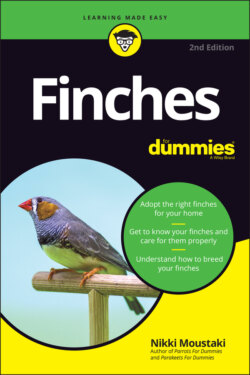Читать книгу Finches For Dummies - Nikki Moustaki - Страница 10
The Many Species of Finches
ОглавлениеOne of the more fascinating things about finches is their seeming endless variety. They range from very delicate to very hardy birds, in all colors of the rainbow. Some are drab and others are exceptionally vivid. Many species are dimorphic, which means that you can distinguish the gender of the bird just by looking at it. Others are monomorphic, which means that you can’t visually distinguish the genders of the birds.
All finches are scientifically grouped under the order Passeriformes. Passerines (which is what birds in the Passeriformes order are called) comprise more than half of the bird species in the world, with nearly 5,400 members. Not all Passerines are finches, but all finches are Passerines.
Though no one expects you to become an ornithologist (someone who studies birds), in order to provide a good home for your companion finches, it can be helpful to understand where your bird is classified in the scheme of things. Here are the four different groups of finches:
Fringillidae: The more than 200 (some sources say 227) members of this group are often called the “true” finches. This family includes the canaries, chaffinches, some siskins, rosefinches, goldfinches, and bullfinches. These finches are adapted to crush seeds and, as a result, they have strong skulls and jaws. These finches are found on all continents.
Passeridae: This group of around 40 finches includes sparrows and snowfinches. Formerly found only in Europe and the surrounding areas, these finches have now been introduced to habitats all over the world. Two types of Passeridae are commonly found in the United States, including the house sparrow. As a group, they are hardy and gregarious songbirds.
Estrildidae: Included in this group of around 140 birds are some the most popular companion finches, including grass finches, parrot finches, waxbills, society finches, greenfinches, serins, firefinches, firetails, quailfinches, Gouldian finches, mannikins, nuns, munias, Java sparrows, cordon-bleu finches, cut throats, and zebra finches. The majority of finches in this group are from a temperate climate, preferring warm weather. They tend to be flocking birds and are all seed-eaters.
Ploceidae: This group has approximately 120 members, including the whydahs (also called widowbirds) and weavers (also called bishops). They are found primarily in Africa and India and can be more aggressive in their response to other birds than some of the more commonly kept species.
One of the longest domesticated and most popular varieties of finch is the well-known canary (see Figure 1-1). Canaries come in a variety of colors, from bright yellow, like the famous Tweety Bird, to brown, gray, orange, white, and variegated (having either regular or uneven dark markings). Canaries are delicate birds, originally from the Canary Islands, and have been a popular companion in Europe since the 16th century, perhaps even earlier.
FIGURE 1-1: Canaries are among the most popular types of finch.
Most people buy a canary for his beautiful song. The males are the singers of the species, and they’re generally the gender that you’ll keep if you want to hear singing in your home. The females can make great companions too, but they won’t launch into song the way a male will.
The canary’s song depends largely on the type of canary that you choose. Some canaries sing a variety of songs, whereas others are trained only to sing in a certain manner. Yes, canaries have to be trained to sing. Many breeders keep an “expert” singer, a canary with a particularly masterful song, in a cage within earshot of young males. The youngsters will learn from this maestro and, hopefully, pick up the essentials of beautiful singing. Some interesting research has shown that birds can actually learn songs when they are developing inside the egg! Don’t worry if you don’t have a master singer to teach the young males their trade; CDs and audio files of canary songs work just as well (you can buy these online or play them for free on YouTube).
